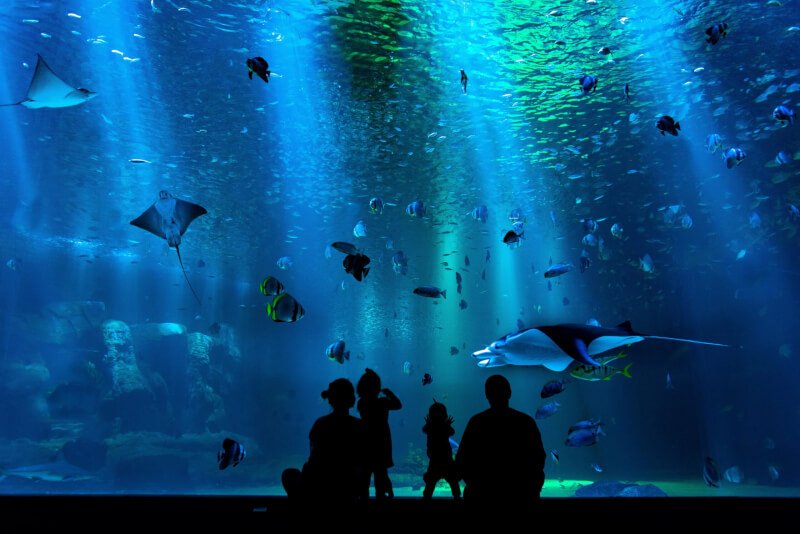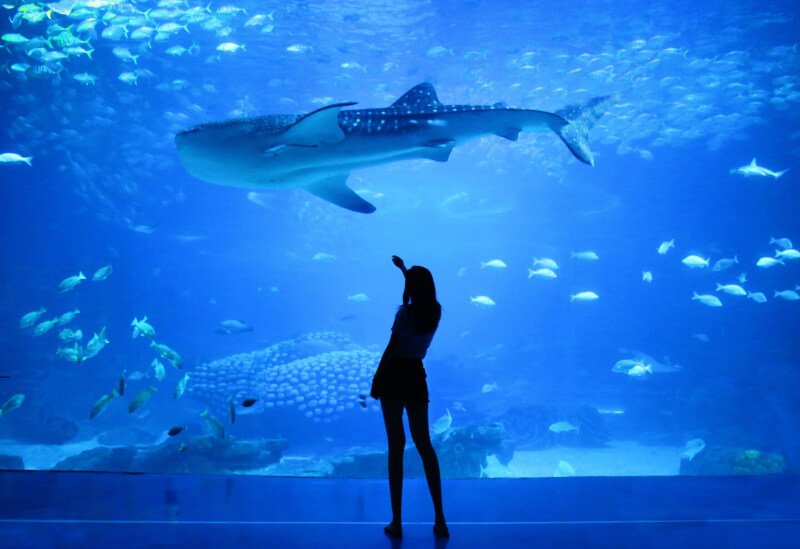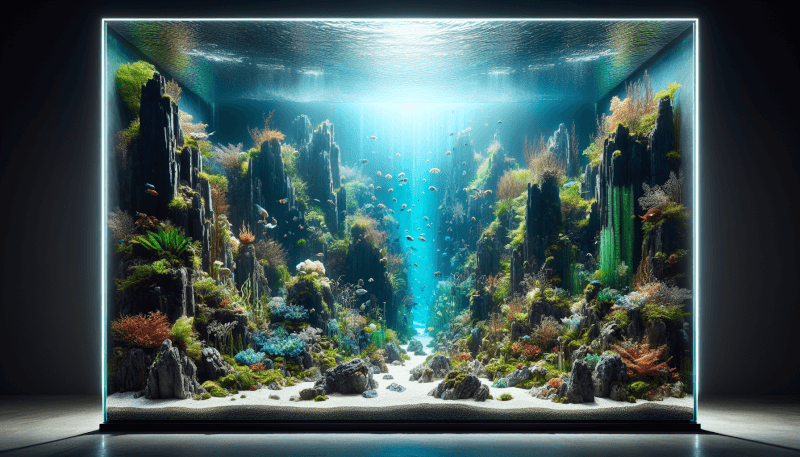Imagine transforming your aquarium into a serene and captivating underwater paradise, where vibrant coral reefs sway gently and colorful fish dart playfully amongst the rocks. Creating a beautiful underwater landscape in your aquarium not only enhances the aesthetic appeal of your tank, but also provides a soothing and relaxing environment for your aquatic pets. With a few simple tips and tricks, you can easily bring the wonder of the ocean into your own home and create a breathtaking aquatic scene that will leave you and your guests mesmerized. Let’s dive in and explore the art of creating a beautiful underwater landscape in your aquarium.

Choosing the Right Aquarium
When it comes to setting up an aquarium, choosing the right one is essential. Consider the size and shape of the aquarium, as it will dictate the amount of space available for your aquatic pets. A larger tank provides more swimming space and can accommodate a wider variety of fish species. Additionally, the shape of the aquarium plays a role in the aesthetic appeal and functionality. Rectangular tanks are popular as they offer a wide viewing area and provide ample surface area for gas exchange.
Researching the specific needs of the fish you plan to keep is crucial when selecting an aquarium. Different species of fish have different requirements in terms of water temperature, pH levels, and compatibility with other fish. Make sure the tank you choose can provide the right conditions to support the health and well-being of your aquatic pets.
Check the material and construction of the tank to ensure its durability. Glass tanks are a popular choice as they are scratch-resistant, provide excellent visibility, and are easy to clean. Acrylic tanks, on the other hand, are lighter and less prone to breakage, making them a good option for larger aquariums. Whichever material you choose, make sure the tank is well-constructed and free from any defects or leaks.
Evaluating the filtration system is a crucial step in choosing the right aquarium. A filtration system helps to maintain water quality by removing impurities, excess nutrients, and harmful chemicals from the water. Look for a filter that is appropriate for the size of your tank and can handle the bio-load of your fish. A good filtration system will keep the water clear, oxygenated, and free from ammonia and nitrites, creating a healthy environment for your aquatic pets.
Selecting Aquatic Plants
Aquatic plants not only enhance the visual appeal of your aquarium but also provide a natural habitat for your fish. When selecting aquatic plants, it is important to determine their lighting requirements. Some plants require high-intensity lighting, while others can thrive with low-intensity or natural lighting. Make sure your aquarium setup can accommodate the lighting needs of the plants you choose.
Choose plants suitable for your fish species. Some fish may nibble on certain types of plants, so it’s important to select plants that are safe and can withstand their grazing behavior. Additionally, consider the growth rate and size of the plants. Fast-growing plants can quickly take over your aquarium and require frequent pruning, while slow-growing plants may not provide enough coverage. Strike a balance by selecting plants that grow at a moderate rate and can be maintained easily.
Decide between live and artificial plants. Live plants have numerous benefits, such as oxygenating the water, absorbing excess nutrients, and providing natural hiding spots for fish. However, they require more care and maintenance, including proper lighting, fertilization, and trimming. Artificial plants, on the other hand, require less maintenance but lack the natural functions of live plants. Consider your time commitment and preferences when deciding which type of plants to incorporate into your aquatic landscape.
Arranging the Aquascape
Arranging the aquascape is where your creativity and personal touch come into play. Creating a focal point is essential for drawing attention and adding visual interest to your aquarium. This can be achieved by placing a striking piece of driftwood, a cluster of rocks, or a group of brightly colored plants in a prominent location. The focal point should be positioned slightly off-center, following the rule of thirds, to create a more visually appealing composition.
Using the rule of thirds for placing plants and decorations helps to create a balanced and harmonious aquascape. Divide your aquarium into imaginary thirds both horizontally and vertically. Place taller plants or decorations along the back and sides of the tank, while shorter ones can be placed towards the front. This placement creates depth and makes the aquarium appear more spacious.
Consider the needs of the fish for swimming space when arranging your aquascape. Leave enough open areas for fish to swim freely without feeling cramped. Avoid cluttering the aquarium with too many decorations or densely planting it, as this can impede the fish’s movement and cause stress.
Creating visual depth in your aquarium can be achieved by incorporating different levels and heights. Use taller plants or decorations towards the back, gradually decreasing the height towards the front. This technique provides a sense of depth and creates a more natural-looking underwater landscape.
Providing Proper Lighting
Proper lighting is crucial for the health and growth of both your aquatic plants and fish. Determine the lighting requirements for the plants you have chosen. Some plants require high-intensity lighting, while others thrive under low-intensity or natural lighting conditions. Make sure to provide the appropriate lighting to support the photosynthesis process and facilitate plant growth.
Choose the right type of aquarium lights based on the needs of your plants. LED lights are a popular choice as they are energy-efficient, long-lasting, and provide a balanced spectrum of light. They also come in a variety of colors, allowing you to create different lighting effects. Fluorescent lights are another option, providing good light penetration and color rendering. Whichever type you choose, ensure that the lights can be adjusted in terms of intensity and duration.
Set up a suitable lighting schedule to mimic natural light cycles. Most plants require around 8 to 10 hours of light per day, with a period of darkness for rest. Create a consistent lighting schedule and avoid sudden changes in intensity or duration, as this can stress your aquatic plants and fish.
Consider adding a timer for automated lighting. This will ensure a consistent lighting schedule and relieve you from the task of manually turning the lights on and off. Timers also help to regulate the photoperiod, maintaining a stable environment for your aquarium inhabitants.

Maintaining Water Quality
Maintaining water quality is essential for the health and well-being of your aquatic pets. Monitor and maintain appropriate temperature and pH levels suitable for your fish species. Different fish species have specific temperature and pH preferences, so it’s important to ensure these parameters are within the optimal range for their well-being.
Perform regular water changes to remove accumulated toxins, excess nutrients, and waste products. Changing 10-15% of the water every week helps to maintain a stable and healthy aquatic environment. Use a dechlorinator when adding new water to remove any harmful chemicals.
Clean the aquarium equipment regularly to prevent the buildup of debris and algae. This includes cleaning the filter media, removing any algae from the glass, and vacuuming the substrate to remove excess fish waste and uneaten food. Regular maintenance of the equipment helps to ensure its proper functioning and prolong its lifespan.
Control algae growth through proper maintenance. Algae can be unsightly and compete with plants for nutrients. To minimize algae growth, ensure proper lighting and nutrient levels, avoid overstocking and overfeeding, and consider incorporating algae-eating fish or snails into your aquarium. Regularly scrape off any visible algae from the glass to maintain a clear and attractive view.
Adding Substrate and Decorations
Choosing the right substrate is important for the health of your plants and fish. Consider the needs of the plants and fish species when selecting substrate. Some plants require a nutrient-rich substrate, while others can grow in inert gravel or sand. Certain fish species prefer specific types of substrate, such as sandy bottoms for bottom-dwelling species. Choose a substrate that suits the needs of your aquatic landscape and provides a conducive environment for plant growth.
Consider the aesthetic appeal of the substrate when making your selection. Different colors and textures of substrates can create different moods and enhance the overall visual appeal of your aquarium. Play around with different combinations and find the one that complements your aquascape the best.
Select suitable decorations like rocks and driftwood to add interest and create a more natural-looking underwater environment. Ensure the decorations are safe for your fish and do not leach harmful substances into the water. Rocks can be stacked to create caves and hiding spots for fish, while driftwood provides perches and surface area for beneficial bacteria and algae growth.
Creating hiding spots and territories for your fish is important to mimic their natural habitat. Incorporate decorations that provide shelter and hiding places, allowing fish to retreat and feel secure. This is particularly important for territorial fish that require their personal space.

Introducing Suitable Fish Species
Research and choose fish species that are compatible with your aquascape and meet the specific needs of your aquarium. Consider the size, behavior, and water preferences of the fish before adding them to your tank. Some species are more suitable for community tanks, while others require a species-specific setup.
Ensure proper acclimation and quarantine procedures when introducing new fish to your aquarium. Allow the fish to gradually adjust to the temperature and water conditions by floating the transport bag in the aquarium for about 15-20 minutes. Then, open the bag and slowly add small amounts of aquarium water to acclimate the fish before releasing them. Quarantine new fish for a period of time to monitor their health and prevent the introduction of any diseases to your established aquarium.
Monitor fish health and address any issues promptly. Observe your fish for any signs of stress, disease, or abnormal behavior. Changes in appetite, abnormal swimming patterns, or visible signs of illness should be addressed immediately. Consult with a veterinarian or experienced aquarist to diagnose and treat any health problems to ensure the well-being of your fish.
Maintaining Proper Filtration
Choosing the right type and size of the filter is crucial for maintaining proper water quality in your aquarium. Consider the filtration needs based on the bio-load of your fish and the amount of plants in your tank. A filter should be able to circulate and filter the entire volume of water in your tank multiple times per hour. For planted tanks, a filter with gentle flow and a pre-filter to trap debris without disturbing the substrate is ideal.
Understand the filtration needs based on fish and plant load. Both fish waste and decaying plant matter can contribute to an increased bio-load, leading to poor water quality. Ensure your filtration system is capable of removing these impurities effectively to maintain a balanced and healthy ecosystem.
Regularly clean and replace filter media to maintain the optimal functioning of your filter. Different types of filter media, such as mechanical, biological, and chemical, have different lifespans. Follow the manufacturer’s recommendations for cleaning and replacing the media to prevent any buildup of debris or reduction in filtration efficiency.
Monitor the water flow and adjust as necessary. Proper water flow helps to distribute nutrients, oxygen, and heat evenly throughout the tank. Ensure the flow is not too strong, as it can stress or damage delicate plants and fish. On the other hand, stagnant water can lead to anaerobic conditions and the buildup of toxins. Strike a balance by adjusting the flow to meet the needs of your aquatic landscape.

Creating a Balanced Ecosystem
Creating a balanced ecosystem is crucial for the long-term success of your aquarium. Establish a nitrogen cycle by cycling your aquarium before adding fish. This process involves establishing beneficial bacteria colonies that convert harmful ammonia into less toxic forms. This cycle typically takes a few weeks, during which you can introduce small amounts of fish food or pure ammonia to simulate the production of ammonia.
Add beneficial bacteria to the aquarium to support the nitrogen cycle and maintain a healthy balance. These bacteria can be introduced through commercial bacterial supplements or by adding established filter media or substrate from an established tank. Beneficial bacteria help break down waste products and maintain water quality.
Consider introducing live plants and algae eaters to your aquarium ecosystem. Live plants absorb excess nutrients and provide oxygen, contributing to water quality improvement. Algae eaters, such as snails or certain species of fish, help control algae growth by consuming algae and detritus. These organisms play an important role in maintaining a clean and balanced ecosystem.
Avoid overstocking and overfeeding your aquarium. Overstocking can lead to increased waste production and elevated toxin levels. Ensure you have enough swimming space for your fish and that they are not overcrowded. Overfeeding can contribute to excess nutrients and poor water quality. Feed your fish the appropriate amount of food, taking into account their size and dietary needs.
Adding Additional Accessories
Include a heater in your aquarium to regulate temperature. Most tropical fish species require a stable water temperature within a specific range. A heater helps maintain the desired temperature and prevents fluctuations that could stress your fish. Choose a heater that is suitable for the size of your tank and has a reliable thermostat.
Consider adding a CO2 system for enhanced plant growth. Carbon dioxide is an essential nutrient for plants, and supplementing it can promote healthy and vibrant growth. A CO2 system provides a controlled release of carbon dioxide that plants can utilize for photosynthesis. Monitor the CO2 levels and adjust accordingly to maintain a balance that supports plant growth without causing harm to fish.
Install an air pump to increase oxygenation in your aquarium. The oxygen level in the water is crucial for the well-being of your fish, especially in densely planted aquariums where oxygen exchange may be limited. An air pump creates surface agitation, enhancing gas exchange and increasing oxygen levels. Consider the oxygen requirements of your fish and plants when determining the need for an air pump.
Use a thermometer for accurate temperature monitoring. It is important to regularly check the temperature of your aquarium to ensure it remains within the optimal range for your fish. A thermometer allows you to quickly and easily assess the temperature, helping you make any necessary adjustments to maintain a stable environment for your aquatic pets.
Creating a beautiful underwater landscape in your aquarium requires careful planning, attention to detail, and a little bit of creativity. By choosing the right aquarium, selecting suitable aquatic plants, arranging the aquascape thoughtfully, providing proper lighting, maintaining water quality, adding substrate and decorations, introducing suitable fish species, maintaining proper filtration, creating a balanced ecosystem, and adding additional accessories, you can create a stunning and thriving underwater world for your enjoyment and the well-being of your aquatic pets. Cheers to creating your very own aquatic masterpiece!


